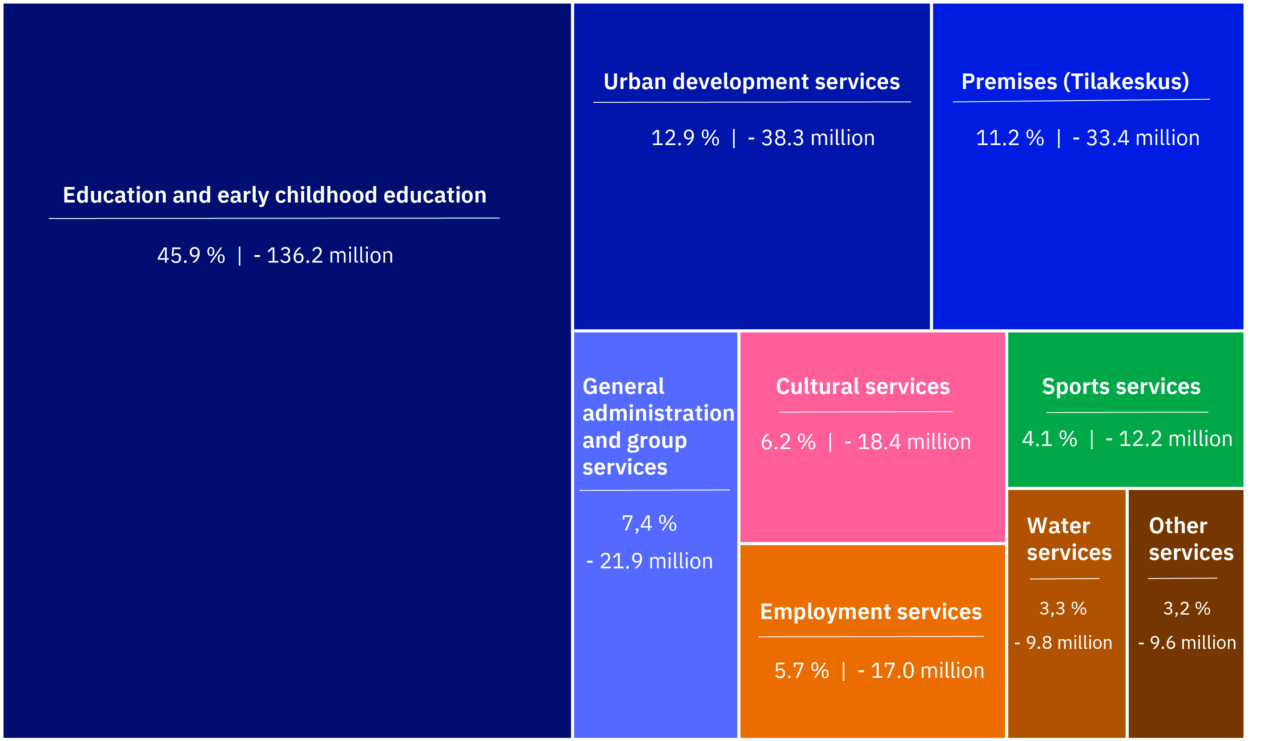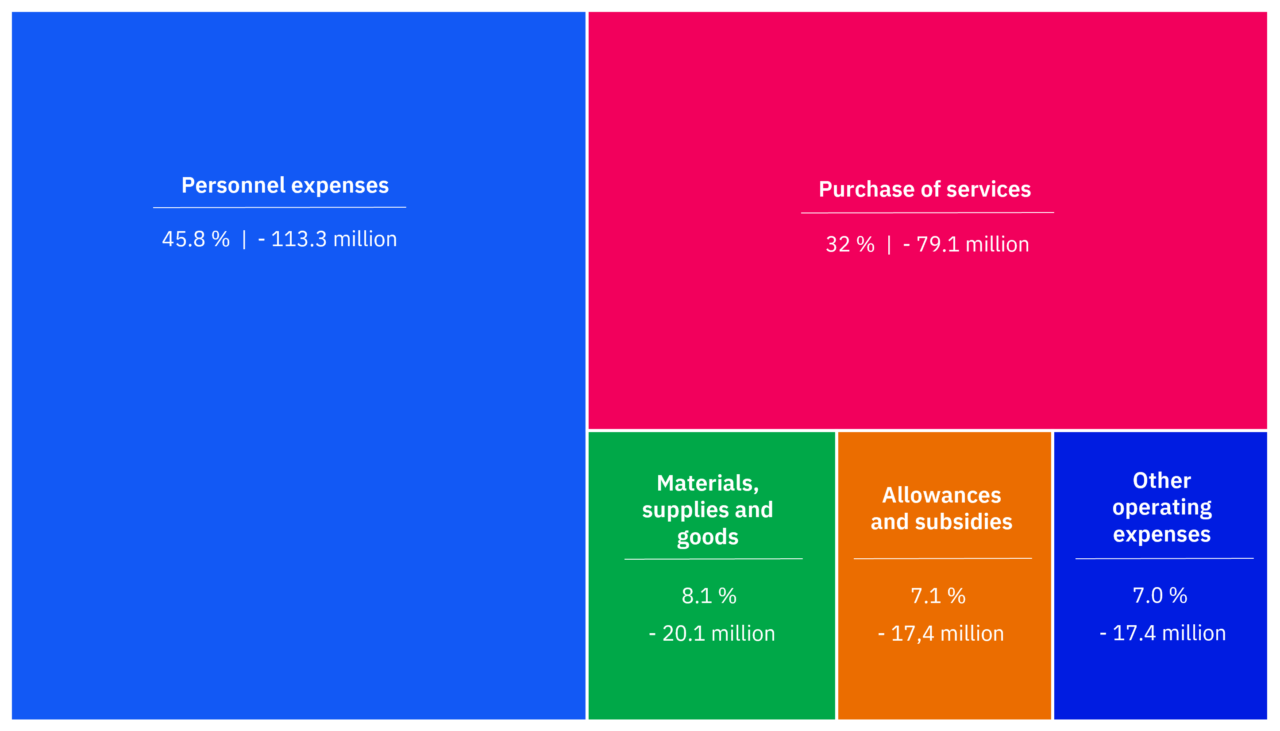The 2023 wellbeing services county reform is the largest municipal reform in the history of Finland, and it has had a significant impact on municipal economies. In 2022, the City of Joensuu’s tax revenues and central government transfers amounted to almost €490 million, and in 2024, after wellbeing services became the responsibility of the state, revenues amounted to around €200 million.
After the wellbeing services reform, not only the income, but also the municipalities’ expenditure decreased as the costs of wellbeing services were transferred to the state. However, due to the new calculation method, the central government transfers received by the City of Joensuu were permanently reduced, which means that the remaining services have to be arranged with a smaller budget.
As the social services have moved away from the municipalities, an increasingly significant part of the City of Joensuu’s expenditure is devoted to the organisation of primary and secondary education and early childhood education. When balancing the economy, we therefore must look at education and early childhood education.
Compared to other cities, the City of Joensuu has organised its services and administration efficiently. This is yet another reason why balancing the economy is proving so difficult. There are no easy savings targets.
What the City of Joensuu does
In addition to education and early childhood education, the City of Joensuu organises cultural and sports services and is responsible for urban planning, land use and water and waste management. The city also plays an important role in environmental protection, building supervision and housing. The city’s key tasks also include employment services, business policy and promoting immigrant integration.
All services provided by the city are considered as a part of the economic adaptation programme.
Expenses are defined in the budget
The expenses required to cover those services and operations that the city is responsible for are set out annually in the budget. The net expenses of the city’s services (expenses deducted from the revenues received from services) amount to 177 million according to the 2024 budget.
Most of the expenditure comes from the organisation of primary and secondary education and early childhood education services. These services account for almost half of the city’s annual expenditure. The city spends around 10% of its annual expenditure on cultural and sports services. The cost of care and maintenance of city-owned premises needed for its service production also accounts for over 10% of the city’s annual expenditure, as do the costs of care and maintenance of streets and public areas, urban planning and land use.

How are the expenses distributed?
The City of Joensuu’s operating expenses can be classified according to their type. Personnel expenses represent a significant part, almost half of the city’s annual expenditure. Approximately 2,800 people are employed by the City of Joensuu. School personnel constitutes the single largest group, 800 employees in total. Next up are the employees in day care centres and family day care, about 750 in total.
Some of the city’s operations are organised by purchasing services from other service providers. Purchases of services account for about a third of the city’s total expenditure. Purchased services include public transport and school transport expenses, purchases of school and day care centre catering services, purchases of construction and maintenance services, municipality of residence reimbursement (e.g. Normaalikoulu) and early childhood education service vouchers through which the city participates in the costs of private early childhood education.
For example, the city buys catering services for schools and day care centres for around €8 million a year.

The purchase of various materials, supplies and goods accounts for just under 10% of the city’s total expenditure. About half of this is due to the use of electricity, heating and water in the city’s premises and services. School teaching material purchases and library material purchases are also included in this group.
Just under a tenth of the city’s annual expenditure is allocated to various allowances and subsidies. This group also includes that share of the labour market subsidy for which the municipality is responsible, which accounts for the most significant part of expenditures related to allowances and subsidies. The city also pays for the home care allowance granted to resident families by Kela. In addition, the city grants a significant number of different allowances and subsidies, such as culture, sports and youth allowances, as well as subsidies promoting resident inclusion.
Rental expenses for premises and equipment, for example, account for just under a tenth of the city’s expenditure. Expenses also include those arising from loan financing needed by the city. The city needs a loan to finance its investments when the annual income (tax income and central government transfers and fees collected for services) is not sufficient to cover the investment costs.
The City of Joensuu’s interest expenditure in 2023 was approximately 4.6 million.
How are expenses impacted?
The various services provided by the City of Joensuu, from day care centres to hockey rinks, are referred to as service production. The level of the city’s service production expenditure can be influenced in different ways.
The cost of service production is mainly influenced by the service network; in other words, how many different units the services are organised in. The scope and quality of services also impact the level of expenditure. The scope of services refers to the opening hours of libraries and swimming pools, for example. Service quality means, for example, the number of daily public transport operations or the number of hours spent performing winter road maintenance. Expenses in service production can also be influenced by efficient and smooth processes.
Compared to other cities, the City of Joensuu has organised its services and administration efficiently. This is yet another reason why balancing the economy is proving so difficult. There are no easy savings targets.



